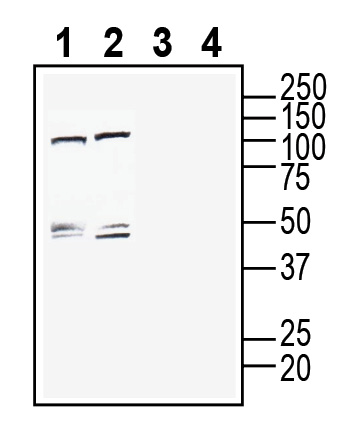Overview
- Peptide (C)RNKENHKPTESSLDEK, corresponding to amino acid residues 87 - 102 of mouse CLEC7A (Accession Q6QLQ4). Extracellular, C-terminus.
 Western blot analysis of rat brain membranes (lanes 1 and 3) and mouse brain membranes (lanes 2 and 4):1-2. Anti-CLEC7A/Dectin-1 (extracellular) Antibody (#ALR-062), (1:200).
Western blot analysis of rat brain membranes (lanes 1 and 3) and mouse brain membranes (lanes 2 and 4):1-2. Anti-CLEC7A/Dectin-1 (extracellular) Antibody (#ALR-062), (1:200).
3-4. Anti-CLEC7A/Dectin-1 (extracellular) Antibody, preincubated with CLEC7A/Dectin-1 (extracellular) Blocking Peptide (BLP-LR062). Western blot analysis of mouse BV-2 microglia cell line lysate (lanes 1 and 3) and mouse J774 macrophage cell line lysate (lanes 2 and 4):1-2. Anti-CLEC7A/Dectin-1 (extracellular) Antibody (#ALR-062), (1:200).
Western blot analysis of mouse BV-2 microglia cell line lysate (lanes 1 and 3) and mouse J774 macrophage cell line lysate (lanes 2 and 4):1-2. Anti-CLEC7A/Dectin-1 (extracellular) Antibody (#ALR-062), (1:200).
3-4. Anti-CLEC7A/Dectin-1 (extracellular) Antibody, preincubated with CLEC7A/Dectin-1 (extracellular) Blocking Peptide (BLP-LR062).
Dectin-1, encoded by CLEC7A, is a small transmembrane receptor that is a member of the C-type lectin family of pattern-recognition receptors (PRRs)1,2. As this receptor specifically recognizes and binds to β-glucans polysaccharides derived from the cell walls of fungi and yeast, it has been characterized for its role in antifungal immunity3.
Dectin-1 is predominately expressed on macrophages, dendritic cells, and neutrophils4,5. Upon ligation of β-glucan, Dectin-1 recruits the adaptor protein CARD9 to phosphorylate spleen tyrosine kinase (Syk) which in turn initiates a signaling cascade which induces phagocytosis and leads to the activation of nuclear factor-κB (NF-κB) and MAPK6. The Dectin-1 Syk mediated pathway has been demonstrated to be activated and involved in the alternative activation of macrophages as Dectin-1 was upregulated in vitro within 4 hours when stimulated with IL-4 and IL-13, cytokines which induce alternative activation of macrophages7. Moreover, the activated Syk pathway has also been implicated in renal interstitial fibrotic disease where it was demonstrated that suppressing Syk in an experimental mouse model of renal fibrosis inhibits the progression of kidney fibrosis, shown by a reduction in mRNA expression of Arginase-1 (murine M2 macrophage marker)8.
While the Dectin-1 pathway has been shown to be involved in the bleomycin-induced model of skin fibrosis, Dectin-1 signaling and receptor expression has yet to be investigated in the context of pulmonary fibrosis9.
